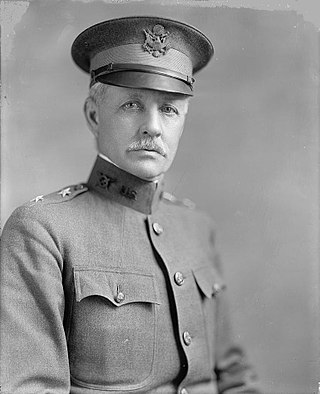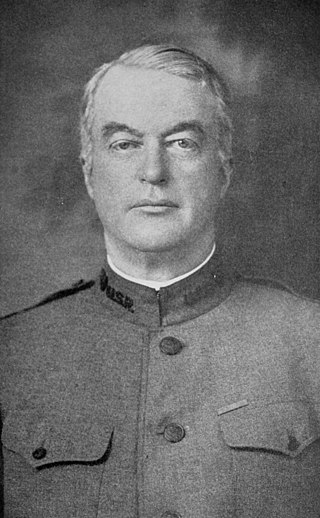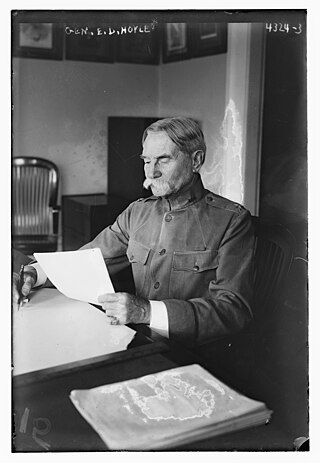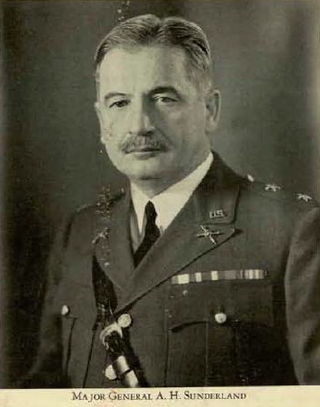
General Tasker Howard Bliss was a United States Army officer who served as Chief of Staff of the United States Army during World War I, from September 22, 1917 until May 18, 1918. He was also a diplomat involved in the peace negotiations of the war, and was one of the co-signatories of the Treaty of Versailles for the United States.

John Loomis Chamberlain was career officer in the United States Army. A veteran of the American Indian Wars, Spanish–American War, Philippine–American War, and World War I, he attained the rank of major general and was most notable for his service as Inspector General of the United States Army from 1917 to 1921.

Augustus Peabody Gardner was an American military officer and Republican Party politician from Massachusetts. He represented the North Shore region in the Massachusetts Senate and United States House of Representatives in the early 20th century. Through his marriage to Constance Lodge, Gardner was the son-in-law of Henry Cabot Lodge.

Charles Justin Bailey was a major general in the United States Army who commanded the 81st Infantry Division during World War I.

Major General Logan Feland was a United States Marine Corps general who last served as commanding general of the Department of the Pacific. Feland served during the Spanish–American War, the occupation of Veracruz (1914) and in World War I, where he was in command of all troops during the Battle of Belleau Wood.

Eli DuBose Hoyle was a brigadier general in the United States Army. He is most noted for his command of the port of embarkation at Governor's Island in New York Harbor during World War I, for which he received the Distinguished Service Medal and Soldier's Medal.

Clement Alexander Finley Flagler was a United States Army Major General who was noteworthy as regimental, brigade and division commander in World War I.

Lucien Grant Berry was a brigadier general in the United States Army who served in three wars.

Major General George Hamilton Cameron was a United States Army officer who had a military career spanning over forty years, at the end of which he attained the rank of major general. Despite serving in numerous conflicts, perhaps his most notable service came in the final years of World War I, where he served as the first commander of the 4th Division, which he later commanded on the Western Front in mid-1918, before being promoted to the command of V Corps, which he led during the short Battle of Saint-Mihiel and then in the early stages of the Meuse–Argonne offensive, the largest battle in the U.S. Army's history, before he was suddenly relieved of his command.

Montgomery Meigs Macomb was a United States Army Brigadier General. He was a veteran of the Spanish–American War and World War I, and was notable for serving as commander of the Hawaiian Department, the Army War College, and Fort Sill.

Andrew Hero Jr. was a major general in the United States Army who was prominent for his service as Chief of Coast Artillery.

William Chamberlaine was a career officer in the United States Army. A graduate of the United States Military Academy and a veteran of the Spanish–American War, Chamberlaine was most notable for his service as a brigadier general in charge of artillery units during World War I.

Clare Hibbs Armstrong was a highly decorated officer in the United States Army with the rank of brigadier general. A graduate of the United States Military Academy, he was the commanding officer of the 50th Anti-Aircraft Artillery Brigade during the air defense of Antwerp during World War II. The 50th Anti-Aircraft Artillery Brigade destroyed 97% of all V-1 flying bombs aimed at the docking facilities that supplied the 12th and 21st Army Groups.

Louis A. Craig was a career officer in the United States Army. He attained the rank of major general, and served in both World War I and World War II. Craig served as a corps and division commander during World War II and was the Inspector General of the Army from 1948 to 1952.

William Lassiter was a career in the United States Army. He was a veteran of the Spanish–American War, Occupation of Veracruz, World War I, and the occupation of the Rhineland and attained the rank of major general.

Colden L'Hommedieu Ruggles was a career officer in the United States Army. A prominent member of the Ordnance Corps, he attained the rank of brigadier general, and was notable for planning and overseeing construction of Aberdeen Proving Ground, Maryland. In addition, he was noteworthy for his service as acting Chief of Ordnance in 1930.

Archibald Henry Sunderland was a career officer in the United States Army. A veteran of the Philippine–American War and World War I, he attained the rank of major general and was most notable for his service as the Army's Chief of Coast Artillery from 1936 to 1940, after which he retired from the military.

Henry Davis Todd Jr. was a career officer in the United States Army. A veteran of the Spanish–American War and World War I he attained the rank of major general and was most prominent for his command of several Field Artillery and Coast Artillery units during and after the First World War.

Ernest Hinds was a career officer in the United States Army. A veteran of the Spanish–American War, Philippine–American War, and World War I, he attained the rank of major general and was notable for his service as Chief of Artillery for the American Expeditionary Forces during the First World War and his post war command of the 2nd Division and United States Army Field Artillery School.

Andrew Moses was a career officer in the United States Army. A graduate of the United States Military Academy, he served from 1897 to 1938, and was a veteran of the Spanish–American War and World War I. He attained the rank of major general and was most notable for his service as commander of 156th Field Artillery Brigade, 81st Division during the First World War, the Hawaiian Division and Schofield Barracks from 1936 to July 30, 1937, and the Hawaiian Department from 1937 to 1938.




















